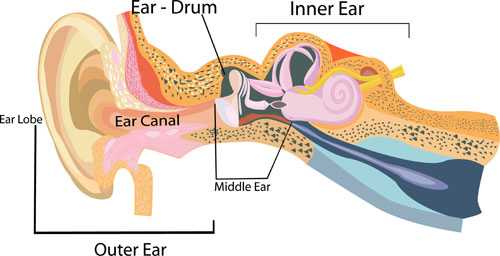Types of Hearing Loss

A hearing loss can happen when any part of the ear or auditory (hearing) system is not working in the usual way.
Outer Ear
The outer ear is made up of:
- the part we see on the sides of our heads, known as pinna
- the ear canal
- the eardrum, sometimes called the tympanic membrane, which separates the outer and middle ear
Middle Ear
The middle ear is made up of:
- the eardrum
- three small bones called ossicles that send the movement of the eardrum to the inner ear
Inner Ear
The inner ear is made up of:
- the snail shaped organ for hearing known as the cochlea
- the semicircular canals that help with balance
- the nerves that go to the brain
Auditory (ear) Nerve
This nerve sends sound information from the ear to the brain.
Auditory (Hearing) System
The auditory pathway processes sound information as it travels from the ear to the brain so that our brain pathways are part of our hearing.
There are four types of hearing loss:
- Conductive Hearing Loss
Hearing loss caused by something that stops sounds from getting through the outer or middle ear. This type of hearing loss can often be treated with medicine or surgery.
- Sensorineural Hearing Loss
Hearing loss that occurs when there is a problem in the way the inner ear or hearing nerve works.
- Mixed Hearing Loss
Hearing loss that includes both a conductive and a sensorineural hearing loss.
- Auditory Neuropathy Spectrum Disorder
Hearing loss that occurs when sound enters the ear normally, but because of damage to the inner ear or the hearing nerve, sound isn’t organized in a way that the brain can understand. For more information, visit the National Institute of Deafness and Other Communication Disorders.
The degree of hearing loss can range from mild to profound:
- Mild Hearing Loss
A person with a mild hearing loss may hear some speech sounds but soft sounds are hard to hear.
- Moderate Hearing Loss
A person with a moderate hearing loss may hear almost no speech when another person is talking at a normal level.
- Severe Hearing Loss
A person with severe hearing loss will hear no speech when a person is talking at a normal level and only some loud sounds.
- Profound Hearing Loss
A person with a profound hearing loss will not hear any speech and only very loud sounds.
Hearing loss can also be described as:
- Unilateral or Bilateral
Hearing loss is in one ear (unilateral) or both ears (bilateral).
- Pre-lingual or Post-lingual
Hearing loss happened before a person learned to talk (pre-lingual) or after a person learned to talk (post-lingual)
- Symmetrical or Asymmetrical
Hearing loss is the same in both ears (symmetrical) or is different in each ear (asymmetrical).
- Progressive or Sudden
Hearing loss worsens over time (progressive) or happens quickly (sudden).
- Fluctuating or Stable
Hearing loss gets either better or worse over time (fluctuating) or stays the same over time (stable).
- Congenital or Acquired/Delayed Onset
Hearing loss is present at birth (congenital) or appears sometime later in life (acquired or delayed onset).
About Sound
In order to better understand hearing loss, it helps to understand how we hear. Sounds are described in terms of their frequency or “pitch” and intensity or “loudness.” Learn about sound »
- Page last reviewed: February 18, 2015
- Page last updated: February 18, 2015
- Content source:



 ShareCompartir
ShareCompartir